Warning: this post contains graphic images from a mature-rated video game.
Part 1 of this review covered art, plot, and storytelling elements.
Hey all,
When it comes to simulators focused exclusively on banishing demons back to the fiery depths from whence they came, nothing springs to mind faster than the Diablo franchise. Diablo III‘s combat system builds off of the formulas of its predecessors but throws in a considerable amount of flavor of its own.
Descending into Barbarism
Diablo III sports five classes: Monk, Wizard, Demon Hunter, Witch Doctor, and Barbarian. The Wizard zaps with a variety of spells of ice, fire, and arcane; the Witch Doctor throws Voodoo-powered animals (alive or dead) at enemies; the Demon Hunter tosses bolas, lays traps, and shoots enemies; the Monk relies on his agility and defensive maneuvers and a long staff to keep enemies at bay. I chose to play a Barbarian, a close-combat specialist with a penchant for smashing things with huge weapons.
I always like play tough characters, so I decided that my Barbarian would be specialize in sword and shield. You can also use two-handed weapons or a weapon in each hand. Yay smashing things!
The “Action” Part of the Action RPG
The heart of Diablo III is its combat system. Each class has a resource mechanic that determines the ebb and flow of their combat style.
The mechanics follow one of two paradigms: either ramping up (more abilities are unlocked as the fight goes on) or winding down (it is easier to do damage/use abilities at the start of the fight). For example as a Barbarian, my mechanic is Rage. As I hit enemies I build rage and then can spend the rage to activate my more devastating abilities. Out of combat, my rage slowly dissipates.
I also have a Wizard alternate, who uses the swiftly regenerating Arcane Power resource to power his spells. Because of this, it makes playing the two classes feel quite unique: as a Wizard, I front load the battles and try to get them over as quickly as possible, but as a Barbarian I try to keep the enemies coming to stay in combat for as long as possible.
For both of my characters the feel of the combat is superb; one thing that Diablo III does really well is make you feel powerful as a player. There is nothing more satisfying than leaping into a large group of enemies and throwing them about with powerful attacks, or watching a skeletal warrior’s shield spin for a few seconds after its master has been blown apart by a mighty blow, or crushing large groups of enemies with a single overpowering attack. Each ability has its own animation and a distinctive “oomph” to it.
I can’t speak too much to the diversity of all of the classes, but my two characters play quite differently and have very different spell/skill sets. It’s been a very different feel and it makes me want to give the other three classes a try.
Choosing a Path
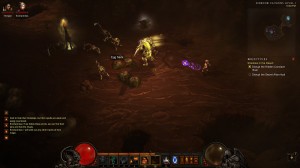
Although the Barbarian’s ranged attacks are meager, you can use one of several abilities to get up close and personal virtually instantly. I prefer to hop heroically.
The way that the skill system works in the game is relatively simple: as you level up, you unlock more skills in a predetermined order. From the skills that you have unlocked, you can choose up to six to have available to you at any point. Unfortunately, the game forces you to use one skill from each of a predefined group of skills unless you uncheck the ambiguously named “Elective Mode” in one of the menus.
Each spell or ability also has 5 “runes” that can be attached to it, each one modifying the base ability in some way. Take the Barbarian’s Rend ability, for instance: by default, it causes the Barbarians to spin in a circle and afflict all enemies in a small radius with a minor damage-over-time bleed effect. However, applying the “Ravage” rune increases the range of the ability, whereas “Blood Lust” causes the bleed to transfer life to the Barbarian, and the “Lacerate” rune increases the base damage of the ability.
In addition to these active abilities you may also select up to three passive abilities. These passives are generally quite powerful and will lend themselves to a particular build or play style. For instance, the Barbarian can choose to get passives for an additional chance to critical hit, or to do more damage when full of rage, or to take less damage from magical attacks, to name just a few.
When you look at the number of passives (sixteen per class) and the number of activated abilities (~20 per class) and the number of runes (5 per activated ability), you can quickly tell that the number of gameplay styles is enormous.
With all of those choices, it’d be easy to get stuck with a build that is not viable. I mentioned earlier that I decided to specialize in sword and board. I found out that this isn’t technically true, since in Diablo III you can switch out any skills that you have learned at any point (though doing so will induce a minor cooldown, so you can’t abuse this too much in battle).
This means that for any given fight you can adjust your skills to suit your needs. If you know you are about to fight a big boss, you can add in your powerful cooldown abilities, or add additional single-target powers and get rid of your area of effect spells. I like that this gives the player the freedom to experiment with different builds without having to invest dozens of hours of gameplay like the previous installments. However, because a level 60 Barbarian has access to all skills of the Barbarian class, there is never a reason for me to level up a new Barbarian once I hit 60. Still, given the variety of classes and the complexity of gameplay for each class, I think that this it is a fair trade to exchange some replayability for the flexibility of trying new builds at 60.
The Little Bad Guys
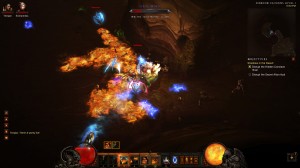
This elite pack of bat-things leaves fire in their wake, shoots electric bolts, and can periodically lock me in place…
What good are fancy spells and heroic acts of barbarism if there are no demons to fight? I can tell you: not much.
Luckily, Diablo III has no shortage of enemies. Demons and undead swarm the game’s maps (which are much less randomly generated than before), coming in a variety of trash packs, elite packs with randomly assigned powers, unique monsters, and boss monsters… that are so large they fill my screen.
Trash monsters are… more speedbumps than actual dangers. They’ll attack in medium sized packs with a basic ranged or melee attack, but can be dispatched quickly. As a Barbarian, I can wade through these enemies quite easily, at least up through Act II on Hell difficulty (where I currently am).
The elite packs are a bit more interesting: each monster has more health and a more powerful attack than its regular variation, but in addition they will have some number of special abilities. The unique monsters behave much the same as the elite packs, but instead of 4-5 monsters being slightly more powerful, there is a single monster that is quite strong. For instance, the “Vampiric” special ability causes the monsters to gain life whenever they attack you or your companions; the “Frozen” special ability occasionally launches out a minefield of ice orbs that will freeze you for several seconds; and the “Extra Strong” ability means they are… well, extra strong.
As you progress through the game and play through on higher difficulties, the elite packs and unique monsters will get more and more special abilities. On Hell and Inferno (the highest difficulty setting), the various combinations of special abilities makes these packs the most fun battles in the game. It’s been fun to sit in Ventrilo and call out the packs that I come across and note which abilities give me headaches, and listen to my friends running across troublesome packs of their own. These encounters have easily been the most difficult part of my journey through Hell difficulty.
The Big Bad Guys
Sometimes you come across really, really big bad guys. Boss encounters occur periodically throughout the story, each with a unique set of powers and often involving several phases. Unlike the elite packs and unique monsters, the boss’ abilities are predetermined and, from what I can tell, constant across difficulty levels (correct me if I’m wrong here). In this way, I’ve found that the boss battles are somewhat anti-climatic; after you have seen what each one does you’ll know exactly what to expect.
Typically the boss will have some kind of tell that will give you a second to respond to the devastation that they are about to unleash. As a rule of thumb: don’t stand in the fire.
The bosses are certainly imposing and challenging, but their high-health pools and predictable mechanics make them less interesting fights.
Gearing up
There is a truism in the Diablo world: a poet is only as strong as the pen he wields. One thing is certain whether you are looking at the damage of your character or how many hits you can take before you die: it will come down to gear.
Gear is acquired in one of three ways: prying it from the cold, dead hands of an enemy; crafting it yourself; buying it with gold (or dollars) from the game’s auction house.
Me? I prefer to pay the iron price. For me, finding new loot from boss monsters or hidden away in chests has always been an important part of the dungeon crawling genre. However, I would say that 90% of the loot that I’ve found or crafted thus far in Diablo III has been complete trash. It is much easier (and cheaper, in the case of crafting) to just search the auction house and buy it with gold. Need a one-handed sword with at least 100 damage per second? You can go buy it in a few minutes.
Because of this, I hardly used the auction house at all. I did fine as I played through the game on Normal or Nightmare, but I feel like I’m somewhat underpowered in Hell now. The game assumes that the player will take advantage of the in-game auction house in order to acquire gear and has been balanced as such. This makes me a little bit sad as I’d rather spend my time playing the game and exploring, rather than browsing my auctions in an Ebay simulator.
We’ll see how I fare when it comes to Inferno difficulty.
Always Offline
As I mentioned way back in Part 1, I think Diablo III has a weak story. Honestly though, my biggest gripe with Diablo III has little to do with the game itself: it is Blizzard’s new “always online” policy. You cannot play the game (or any future Blizzard title) at all unless you are logged into Battle.net. To the casual observer, this might not seem like such a big deal. After all, you have to log into MMO games too, right?
True, to play any MMO, such as Blizzard’s 800-ton gorilla World of WarCraft, you have to log into an online server. However, I’ve spent about 2/3 of my time in Diablo III playing Diablo III by myself. Some players only play by themselves. By forcing the player to connect to an external server, you are adding in the risk of latency by design. In a game that rewards the player for acting quickly and timing attacks precisely, this is detrimental at best and crippling at worst.
In addition to the in-game impediments that this can add, it also puts the player’s enjoyment in the hands of Blizzard’s server maintenance crew. While the majority of this issues occurred during the initial launch of the game, even now the servers will go down on occasion or be filled with so much lag that the game is unplayable.
While not being able to play a game that I’m truly excited about right away would definitely be a bummer, what scares me more about this is that it sets a precedent for games to die. If a game relies on an external server in order to play, if that server goes down or goes away, the game can no longer be played.
You’ll be clicking a lot… and you’ll love it
The world of Sanctuary is besieged by hordes of undead, demons, and other grotesque monstrosities. You, the brave and stalwart hero or heroine, must save the world by clicking.
To move around the world you click. To use your basic attacks, you click. Your character’s special abilities are set up on the number keys, but you can click those too if you’d like.
Even for a veteran gamer like myself the clicking can be a bit much. Maybe it is just because I am getting older, but after any play session lasting longer than an hour or two my wrist would start to cramp up. I recommend taking frequent breaks while playing this game in order to avoid injury!
Worth the Wait?
Overall, I think Diablo III is a great game. Sure, the story is a bit lame and I have concerns about the auction house and Blizzard’s always online stance, but the raw gameplay is just so satisfying that I can overlook these gripes and enjoy a great hack-and-slash game.
Cheers,
S


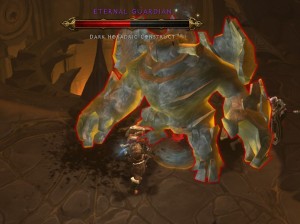
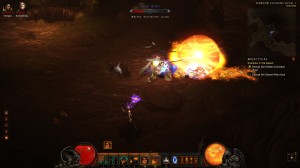
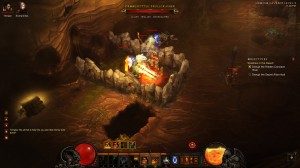
Comments